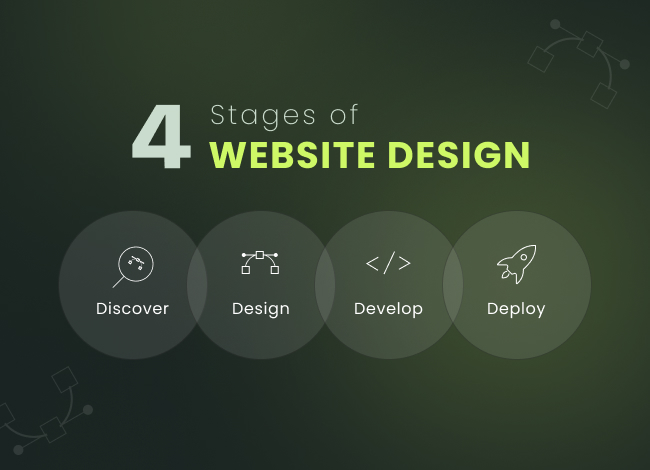Introduction
Every market has changed a lot over the years. Now, businesses are in a constant struggle to get themselves popular and to increase their sales and revenue at a higher pace. To achieve both these targets, websites are serving as the most effective weapon. Having a reliable, robust, and seamless website not only ensures a better reach towards your customers but also helps you to showcase your product and services in a better way. These websites should be created by keeping your brand, your product, and your target audience under consideration to make sure your customers can relate to your website. Nowadays, companies follow various techniques and methodologies to give these websites an attractive design and to make them deliver the ultimate user experience. But what are these website designs? What is their significance? And what stages are involved in creating these web designs? In this article, we will discuss them all.
What is Web Design?
A web design means the aesthetic look and the overall user interface of a website. When creating websites, the design of a website holds the most importance. Different aspects of a website like graphic design, typography, color theory, and user interface (UI) design, are combined to create a visually appealing and engaging website design.
While creating a website, web designers try to make sure that the created website not only delivers the desired message but also helps the brands communicate with their users. Designers make sure that the website design is created by keeping the brand’s target audience, brand identity, industry standards, and technological standards.
Main Features of a Web Design
When it comes to a reliable and robust website design, several components contribute to it. To create an attractive website design, it is always ensured that the created design is visually appealing, user-friendly, and super engaging to make sure it delivers the visitors the best user experience. Following are some main features of a responsive website design that must be focused to make a website successful:
Responsive Design
A reliable and effective website should have a very responsive and compatible design according to all kinds of screen sizes and operating systems. The website should be responsive, adaptable, and easy to use for all users and all kinds of devices like desktops, laptops, tablets, and smartphones.
Clear Navigation
The website should also have clear navigation in its interface. This navigation can include well-organized menus, breadcrumbs, search functionality, and call-to-action buttons that can help users explore the website easily. These features of clear navigation help the users to collect their desired information from the website in an easy way.
Visual Hierarchy
Visually attractive websites are always more successful than dull ones. A website should have a proper visual hierarchy which involves prioritizing and arranging web elements to engage the users. Different techniques like contrast, color, size, and spacing help the designers create a visual hierarchy that can help the user get the desired information easily.
Attractive Visuals
A website should be super engaging to make sure it can attract and retain its users. To make a website attractive, the designers add high-quality images, graphics, videos, and illustrations that help the website to deliver the desired messages. These elements of visual appeal make the website evoke the user’s emotion and engage the user’s interest properly.
Continuous Branding
Whenever an organization’s brand identity, values, and guidelines are tried to be aligned with the website, it can only be done with the help of continuous branding. This continuous branding helps the website to deliver the best user experience with the help of consistent colors, fonts, imagery, and messaging across all pages of the website.
Readable Typography
A super engaging and effective website should have content that is easy to read, easy to understand, and full of information. For this purpose, the website should have an advanced typography that includes appropriate fonts, and font sizes to increase the readability and legibility of the website on different devices and screen sizes.
Interactive Elements
Interactive elements like buttons, forms, sliders, and animations are very important in making a website engaging. These interactive elements help in increasing the website to deliver an attractive and engaging user experience. These interactive elements not only engage the user, but also make the user take action, explore content, and interact with features, ultimately driving conversions and achieving business objectives.
Advanced Security Measures
A reliable website should have very reliable and advanced security measures to make sure it can keep the user’s data safe and secure. These security measures protect the website from cyber threats, data breaches, and unauthorized access. These security measures include implementing SSL encryption, using secure authentication methods, and regularly updating software and plugins to mitigate security risks and vulnerabilities.
Benefits of a Web Design
Nowadays having a reliable and effective website is equal to having a successful business. To make a website an advanced tool, it should have an advanced and engaging design. This website design provides several benefits to the organizations and the companies themselves such as:
Professional Image
Having an attractive website design helps the website to create a professional image in the market. This delivery of a professional image increases the credibility, reputation, and trustworthiness of the website which directly influences the purchasing decisions of the users. This professional image of a website helps the brand to improve its market image which helps in increasing its sales and revenue.
Increased Visibility
Websites with better designs always serve as the best tool that can help businesses increase their online visibility and showcase their products and services in a better way. Websites with better designs increase the discoverability of the websites making it easier for users to find them.
Brand Identity
Website designs help to increase the overall brand identity and to deliver the desired message to the audience. The websites can increase brand recognition and a better engaging user experience for visitors by incorporating consistent branding elements such as logos, colors, fonts, and imagery.
Better User Experience
A better and more advanced web design helps the website to deliver an advanced and engaging user experience. A website having an advanced design is easy to navigate, visually appealing, and user-friendly which helps the website to engage its users and to deliver them a better engagement and user satisfaction.
Increased Engagement
A successful and effective website should be super engaging to make sure that the coming visitors can interact with the website and spend more time exploring its pages. To make a website engaging, the website should have an attractive design including engaging website design elements such as interactive features, compelling visuals, and multimedia content.
Advanced Lead Generation
One of the main purposes of websites is to improve the sales and leads of a company and a website with an attractive design serves as the best tool for it. A website with an engaging design captures a visitor’s attention and converts that into a lead. Strategic placement of different interactive elements such as call-to-action buttons, forms, and lead magnets helps the websites to make their users perform the desired actions.
Boosting Sales and Revenue
Websites serve as the best tool to boost the sales and revenue of an organization. A website with an engaging design can help to increase sales and revenue by facilitating online transactions, showcasing products or services, and driving conversions. Having an effective and easy-to-use website design can help websites to enhance the shopping experience for customers.
Enhanced Customer Service
Besides increasing sales and leads of a business, websites can also serve as a tool to deliver better customer service. A sleek and simple design of a website can provide its visitors easy to easy-to-understand information, resources, and support channels. Websites can deal with user’s inquiries and issues effectively with the help of multiple features like FAQs, knowledge bases, and live chat support.
Better Scalability and Flexibility
An effective website should be scalable and flexible to ensure it can grow along with the business and a scalable and flexible website design is essential for it. When a website has an advanced web design, it can easily entertain changes in content, functionality, and user needs, ensuring that the website remains relevant and effective as the business evolves.
4 Stages of a Web Design
Due to its several benefits and other effective usages, a website is the best tool to help a business boost its sales and revenue and increase its popularity. A website should have an engaging and seamless design to make sure it is engaging its users properly and giving the desired results to the organizations. Following are the four major steps that organizations can follow to create an engaging web design:
The Planning Stage
The first and most important stage while creating a website is to create a proper and extensive plan before creating a website. This plan helps the website to determine its goals, its target audience, the features to be included, and its overall design. Having a proper plan for creating a web design helps development companies stay on track and not get lost in the process of website development. This creation of a plan before starting the development procedure helps the companies to streamline the goals and objectives that organizations want to achieve with the website.
The Design Stage
After the plan for creating the website is finalized, the next step in the creation of the website is the design stage. In this stage, the design of the website is created considering the finalized plan and the demands and objectives that you want to achieve with your website. This stage involves creating a prototype of the website which helps you to check how your website will function and look.
While creating the design of the website, it is advisable to always ensure that the created design is engaging, informative, and has a proper and streamlined layout which involves the proper arrangement of your website content. This also involves finalizing the color schemes, font style, size, photos, and images that you want to add to your website.
The Development Stage
After you have a final design of your website, the next step is to develop your website as per the created design. This development stage involves creating the website including all the planned features and functions in it. During development, the developers incorporate all the interactive elements and other engaging features that help the users interact with the website easily.
The Testing and Launch Stage
The last but not the least stage during the website creation is the stage of testing and launching. After finalizing the design of the website and developing it, the next stage is the testing and launching of the website. This step involves putting the website in a thorough series of tests to ensure the created design is error-free. During the testing process, if any error is found, the developers take immediate action and then remove this error.
After testing the developers move to the next step of launching and launching the website on the user’s domain. This launching helps to check if the website will keep on working as intended without any hurdles in its functioning.
Conclusion
Websites are one of the most effective tools for marketing and increasing sales and revenue. Every other business is nowadays putting all their focus on their websites to make themselves popular and showcase their products and services. To get the best results from a website, it should have an engaging design including clear navigation, easy-to-understand content, and many more. There are four stages of creating a website which include The Planning Stage, The Design Stage, The Development Stage, and The Testing and Launch Stage. So follow all these steps to make sure you have the most reliable web design.






